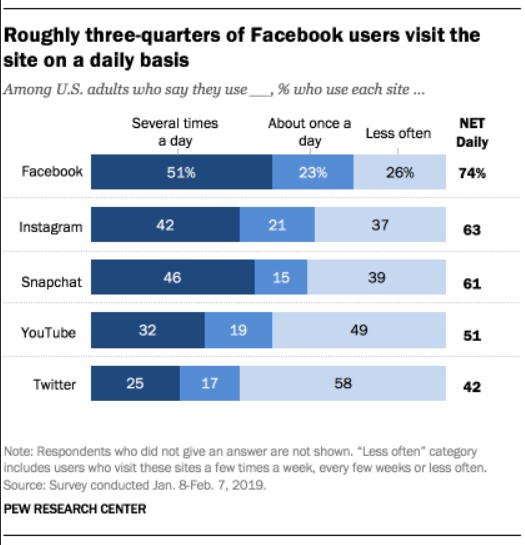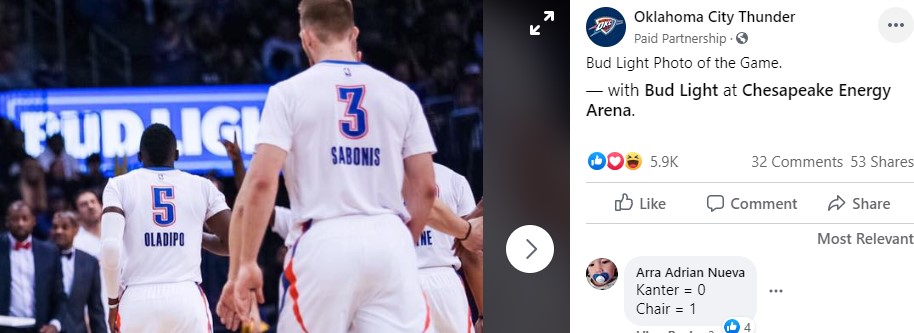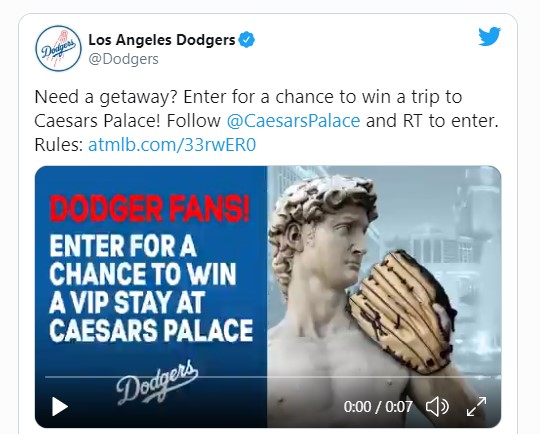 Part 1 provides an overview of the current state of sponsorship use and management.
Part 1 provides an overview of the current state of sponsorship use and management.
Part 2 explores the long-term nature of sponsorship relationships and the resulting importance of fit between properties and brands.
Part 3 establishes the importance of developing the business case for sponsorship as well as contractual considerations.
Part 4 sets forth best practices in sponsorship stewardship and activation.
Part 5 provides an examination of the measurement of sponsorships.
Part 6 explores eSports as a fit for a brand’s sponsorship portfolio.
Part 7 addresses the COVID-19 pandemic and complements the previous installment on eSports.
Part 8 examines the role social media plays in managing and measuring sponsorships.
Part 9 reviews the emerging opportunity from student-athlete “rights to publicity” decisions.
Part 10 looks at what we learned from the first year of college athlete sponsorship.
Identified as an important sponsorship tool in the recent ANA/MASB survey, [1] social media requires context, insight and guidance regarding its use.
As the world has become primarily digital for brands and consumers, more and more marketers rely upon this landscape to magnify the value of their sponsorships. Within this scope, social media platforms facilitate fan discussions in real time – amplifying engagements, expanding reach, and aiding activation. However, the dynamism of this brand-audience interaction makes measurement more challenging, particularly because it is real time – not sustainable over time – and lacks representativeness.
The representativeness of social media dialogue is especially tricky for two reasons. One is that the most vocal on social media often do not fit the profile of the typical consumer. The second is that people self-select with whom they interact on social media. Those who follow brand accounts can often be heavily skewed towards existing, favorably disposed customers and shy of prospects that the marketer would like to bring into the fold. This also makes it difficult to identify meaningful control-comparison groups for measuring response. Exacerbating this, the algorithms used by social media companies can encourage divisiveness, creating an unfriendly brand environment. [2]
Navigating these opportunities and difficulties, this article lays out best practices for the use of social media in the activation of sponsorships and encourages accurate, independent measurement and valuation of social media.
Social Growth and Evolution (the consumer and business context)
Much like digital media has evolved to transform and launch disruptive businesses, social media has evolved well beyond the creation of a network of friends. “Like, fan, and follow” behaviors have developed into a more holistic notion of social business [3] with collaborative utility across the enterprise. This includes robust customer service mechanisms, closed loop product feedback, and customer insights to employee engagement and recruiting.
 With 3.8 billion people around the globe using social media, [4] it’s become part of our collective lives. A full 1.73 billion people on average log onto Facebook daily and are considered daily active users (Facebook DAU) per its most recent quarterly earnings report, up from 1.66 in the prior quarter. [5] The growth, scale, and time spent within social platforms has become an undeniable facet of everyday consumer life. [6]
With 3.8 billion people around the globe using social media, [4] it’s become part of our collective lives. A full 1.73 billion people on average log onto Facebook daily and are considered daily active users (Facebook DAU) per its most recent quarterly earnings report, up from 1.66 in the prior quarter. [5] The growth, scale, and time spent within social platforms has become an undeniable facet of everyday consumer life. [6]
According to Pew Research, a 2019 study showed that among U.S. adults who use Facebook, around three-quarters (74%) visit the site at least once a day. Other platforms also experience high levels of daily active use with the shares of Instagram users (63%) and Snapchat users (61%) visiting those sites at least daily. The enduring growth of social is a result of its ability to deliver 1:1 and one-to-many communication, media publishing and consumption as well as, increasingly, commerce. In 2018, social platforms surpassed print newspapers as a primary source of news. [7]
Social media has also changed the way many of us consume traditional media such as television. Long considered a lean-back medium, TV has become interactive with the use of a second screen. A full 50% of television-related tweets are about sports (Nielsen, 2014), and a recent survey of sports fans shows that 79% access social media while viewing televised sports content and 65% report looking up sports-related information while viewing (Cunningham & Eastin, 2015). [8] Given that the lion’s share of the sponsorship pie is dedicated to sports-related relationships, this underscores a continuing need for marketers and researchers to better understand the impact of cross media usage, second screen ‘distraction’ and the complementary impacts on brand measures.
Live events have always generated lots of conversation prior to the event, during the event, and after the event. Questions like: what song do you think will open the show? Who’s going to score first? Or, what is the most interesting matchup? are prevalent prior to the event. Discussion of game and performance specifics are the preponderance of during-event conversation. Post-event commentary tends to relive the most memorable or event-shaping moments.
Laptops, tablets and mobile devices have taken these conversations to a much broader audience. Having a screen on and being engaged with a device during an event, whether in attendance at the venue or viewing a live transmission, is now standard practice. Second and even third screen engagement with group chats and social media posts enhance the experience for many. They also benefit sponsors. Broadcasters have embraced this behavior by displaying some social media messages during events, promoting specific hashtags or asking for viewer participation.
Some of the first live sporting events after the pandemic hiatus were designed to raise money for Covid-19-related causes such as healthcare heroes and charitable food pantries. Fans had a chance to put photos, presumably their faces, on the side of a NASCAR race car if they engaged during a race. Engagements like these certainly can benefit sponsors if the sponsors are associated with them. It’s important to measure the engagement and value it in financial terms.
A prominent example is Comic Relief U.S.’s Red Nose Day which has raised over $230 million to end child poverty, with over $30 million in 2020 so far. Recently they held a “Celebrity Escape Room” with stars such as Ben Stiller, Jack Black, Lisa Kudrow, Courteney Cox, and Adam Scott. Mars Wrigley, NBC Universal, Walgreens and The Bill and Melinda Gates Foundation co-sponsored the event. [9]
A Growing Role in the Path to Purchase
The above scale and frequency of social media usage gives the time spent on social platforms an opportunity to impact the consumer on the path to purchase. Within a brand’s social media editorial calendar, influencing the path to purchase comes through the interaction with branded content or marketing-generated content and through the user-generated content of followers, some of whom may be staunch advocates. Consumers share their shopping experiences and recommend products and services based on their experiences. The sharing processes in social media may influence users’ behaviors. When it comes to buying influence, one in three U.S. consumers are influenced by social media in their purchases. [10]
Engagement [11]
from the Common Language Marketing Dictionary
Engagement is a general term for measures of the rate of audience interaction with media content as exhibited through various actions.
For social media, engagement is often measured in terms of associated user activity with published branded/user created content including likes, comments, mentions, and shares. READ MORE…
While the term engagement has become marginalized with overuse, as a platform, social media has evolved the term. In 2007, Forrester, along with Charlene Li and Josh Bernoff, conducted early work to categorize engagement beyond demographic segments to categorized heterogenous social behavioral usage in a framework titled, Social Technographics. [12]
The spectrum of behavior begins with passive “spectators” that simply read social media content and ladders up in commitment to “critics” who are more prone to agree or disagree via a quick thumbs-up, vote down or scaled rating/review, all the way up to a top rung of curation and development of original material as a “creator.” IAB in conjunction with the MRC, WOMMA and 4A’s, provide a paid-media-centric definition of engagement that ‘assumes active participation, but may also assume a cognitive or emotional connection in addition to a physical action.” [13]
For the purposes of sponsorship, engagement within social media necessarily needs to take on a spectrum of actions as indicated by the Forrester work in Social Technographics. This definition gets broken into four categories:
- Association – Joining or following a brand as a result of the association to the event or host sponsor.
- Content Consumption – Reading, viewing or listening to social media whether it’s created by the brand, host, participant or viewer of the event or within the media audience.
- Response or Reaction – Preference or forwarding content related to the event via social media platform.
- Curation or Creation – The assembly or modification of content or the creation of new content related to the event in the form of opinions, experiences, advice and commentary.
 As the pace of technology evolution in the emergence of social commerce and lead generation across social platforms has given rise to more elegant product consideration tools, lead generation mechanisms and transactions within the social media platform go beyond traffic referral to a website or app.
As the pace of technology evolution in the emergence of social commerce and lead generation across social platforms has given rise to more elegant product consideration tools, lead generation mechanisms and transactions within the social media platform go beyond traffic referral to a website or app.
The Social Media and Sponsorship Context
By their nature, sponsorship opportunities revolve around the aggregated audiences of value. While these audiences may reconstitute regularly over the course of a season, they assemble and disperse in moments of time. Sure, there are exceptions such as the complementary pen with logo, t-shirt from an in-stadium ‘cannon’ or the amazing Anthony Rizzo bobblehead giveaway at Wrigley Field that become family heirlooms. Except for pouring rights and sampling opportunities, the majority of the investment is assessed as a fleeting impression amidst a very cluttered environment. The range of traditional sponsorship touchpoints allow attendees, or viewers in the case of media coverage, one time or intermittent exposure to the sponsoring brand’s cues, symbols and messaging.
 Enter digital & social media and the age of interactivity in sponsorship. Through the proliferation of mobile devices and social media, attendees can be more active participants in an event whether they attend in person or view from across the globe. As a result, social media can add to sponsorship activation as well as aid awareness, connection and engagement in the promotion of the sponsored activity.
Enter digital & social media and the age of interactivity in sponsorship. Through the proliferation of mobile devices and social media, attendees can be more active participants in an event whether they attend in person or view from across the globe. As a result, social media can add to sponsorship activation as well as aid awareness, connection and engagement in the promotion of the sponsored activity.
Research to identify a typology of social content validated the two-way nature and examined audience fit with social content served to differentiate social vs. paid digital and traditional on-site (venue) activation tactics using the 2012 Olympics for analysis[14] to provide a foundation for this differentiation. Fast forward to the 2018 PyeongChang games, dubbed “the Social Olympics,” [15] and it indicates the widespread usage of social media across athletes, sponsors, the venue and IOC accounts to amplify content and gain audience attention.
It’s clear that both social savvy brands and athletes utilized the global stage of the Olympics to build their social footprint. As social media evolves as a strategic activation lever for sponsorship, it provides an easy-to-use outlet for fan passion and conversation in addition to being a viable channel to efficiently target the avid fan with little waste.
Tactically, the combination of dedicated event, brand and sponsor pages on all platforms, along with mechanisms such as hashtags (#), provide a feedback loop. These tactics aid assessment of event-brand fit to gauge relative interest among fans and potential fans. They also encourage event attendance and cede participation in conversations before, during and after a sponsorship occurs. This “real-time” feedback can be helpful as an early warning and can also create contextual understanding, enabling quick modifications to activation. Even one negative comment can act as the ‘canary in the coal mine’ to alert the sponsor that an activation alteration may be in order. By leveraging the content derived from social media, savvy marketers engage potential customers with messages not solely focused on making a sale.
Sponsors that create a more enduring connection with consumers do so by integrating traditional and social activation levers to enhance the overall experience for the audience. This best practice of integration creates a lasting connection for the brand, event and end customer. Within social, the end result will manifest itself not only as a revenue-driving consumer but as an advocate for the brand.
Laying the Groundwork for Social Media Measurement in Sponsorship
Industry measurement of social media related to brands and events are largely based on volume and an element of sentiment. Measurement is also complicated by the very thing that makes social media unique – its value to brands as a medium where both the business and the consumer participate in the creation, publishing and amplification of content. The range of content types (text, video, images) presents a challenge to social-listening technologies and resources. It is also both a real-time/moment-in-time activity and a longer-term measurement opportunity for brands that increase their following due to sponsorship activation. Traditional media monitoring firms have expanded existing practices around media valuation to include social media and new firms are leaning into the sponsorship analytics space with a tech-driven mix of monitoring, dashboards and analytics providing relative comparisons.
For all the richness that social media delivers to sponsorship activation, one should be careful using social media to measure ongoing sponsorship results. Like any brand environment (sponsorship, media, retail, ecommerce), care should be given to understanding the challenges and aligning the right metrics in the context of the goals and objectives.
Organizational/Brand Value Drivers
Similar to broader digital maturity analysis, an assessment of these organizational drivers helps marketers understand their ability to take on the task of sound measurement.
- Social business maturity – A thorough audit of both the brand and sponsor digital landscape will provide insight into the social business footprint. Marketers utilize social for customer service, lead generation and commerce in addition to driving impressions and engagement.
- Insights – Iterative and closed loop use of social driven data can inform brand and business strategy. If data is collected but not communicated or used outside of sponsorship and social media teams, the organization is missing out on valuable customer feedback.
- Social media platform utilization (lead gen, ecommerce, product discovery) – Use of social platforms to reduce friction for attributable revenue-generating activities are now available on Facebook, Instagram and Pinterest with TikTok and others in test & learn mode. Each platform is measured uniquely, and the lack of consistent cross-social platform measurement limits the ability to gauge audience overlap. However, marketers can generate further insight on which platforms best acquire customers.
Social Activation Measures
Among the range of measures available to the marketer, impressions are a basic measure of value. But bot activity creates an unmitigated risk of inflation. Engagement measures provide additional information, most often in regard to action taken by the user. If positive, this can be a precursor of commitment to the brand. Traffic back to a brand’s own website or app creates the opportunity for conversion.
- Reach & impressions at the post level – Impressions are how many times a post shows up in someone’s timeline and reach is the potential unique viewers a post could have (usually your follower count plus accounts that shared the post’s follower counts). Without an impression, nothing else can happen. But what matters is what happens next.
- Engagement (likes, video views, comments and shares) – Every network will have some sort of engagement metric that is a total sum of smaller engagement metrics such as likes, comments and shares. High engagement rates will indicate audience health (how responsive the audience is and how many are “real” followers).
- Increase in followers – Number of fans/followers along with weekly growth. Again, similar to impressions, followers should be monitored for validity.
- Traffic from social media – Content consumption, site search, page views and lead generation are all valuable metrics as sponsor-driven visits from social media to a website or app. Conversion to revenue through transactions.
Social Media Measurement
- Baseline measures – Organizations with dedicated staff and/or agency partners should establish baselines for the above activation measures so brands can gauge performance based on norms year over year, month to month, day of week and time of day along with type of content/post.
- Consistent reporting – In a world where social media platforms continually change their newsfeed algorithms, creating consistency over time can be difficult. Further, a switch from one social listening tool to another will create a different reading in sentiment.
- Sponsorship event measurement – Sponsorship events may create a different flow and type of content than the routine social media editorial calendar. Recurring events such as a sport season or regional conferences can establish norms and support analysis of impact by gauging post response. This will support recommendations for optimization of the content.
- Traffic, leads and transactions – The social editorial calendar is a finite resource. Experienced marketers understand that bombarding the feed and consumers with posts will do more harm than good. Sponsorship-related traffic, leads and transactions should be gauged against the business as usual performance.
For all its benefits, social media is not without its limitations. To MASB, there are three core challenges with social media measurement:
- The activities and interest captured in social media measures do not meet the characteristics of an ideal metric. (see Marketing Metric Audit Protocol)
- The measures are typically not sustained and cannot be independently validated.
- There is no evidence that measures of interest, likes, shares, followers, or sentiment can be linked to the business outcomes most correlated to market share and price premiums. (see Sponsorship Accountability Part 5: Measurement)
Due to these factors, social media measurement at present is limited to media equivalency in the Sponsorship Measurement Hierarchy.
Social Media in the Sponsorship Measurement Maturity Hierarchy
To provide structure and insight into sponsorship measurement, the MASB Sponsorship Accountability Metrics Project developed the Sponsorship Measurement Maturity Hierarchy to illustrate how to improve sponsorship accountability with measurement. This illustrates how the best marketers link return on objective (ROO) measures of consumer attitudes and behaviors to financial outcomes. See Part 5 of this series for more detail.
Brand preference has been shown to have three benefits over other ROO measures that are especially relevant for sponsorship. First, brand preference has a compelling relationship to sales outcomes, both in terms of market share and sustaining price premiums. This makes it a convenient and valuable metric to include in sponsorship lift studies as it enables the financial return on investment to be calculated.
Second, brand preference relationship to sales is stronger than all other measures examined. Other measures tend to focus on a specific aspect of brand building; generating awareness, perceptions of value, loyalty, etc.
 Third, brand preference captures the sales impact of these other measures regardless of the target or objective. Since sponsorships tend to extend across many years and many different brand objectives, this “cornerstone” capability of building brand preference is highly desirable.
Third, brand preference captures the sales impact of these other measures regardless of the target or objective. Since sponsorships tend to extend across many years and many different brand objectives, this “cornerstone” capability of building brand preference is highly desirable.
For these reasons, MASB recommends using brand preference as a key measure in sponsorship measurement.
Summary
The scale, frequency of use, and role in the consumer connectivity to brands make social media platforms an important consideration for marketing strategies. The inclusion of social media in the framework of sponsorship relationships between brands and hosts has become a valued component by brand stewards, though systematically accounting for that value is elusive.
Social media’s unique qualities as a consumer and business platform and its rapid technology evolution do not lend themselves to straightforward measurement and valuation. When this unique, omni-directional communication mode is combined with self-selection and the heterogeneity of each platform, traditional measurement tools for TV, print, outdoor and radio have not produced consistent measures of accountability. Marketers are left with social media as an enabling vehicle that is a means to an end, generating engagement and impressions that have a legacy of activity-based measurement while an associative value of persuasiveness is missing.
In order to support the hypothesis that social media impacts brand measures, the industry must contextualize and validate its impact on a sponsorship within the customer journey. This approach should:
- be platform agnostic, inclusive and independent
- provide reproducible research frameworks
- inform outcomes and not simply measure activities
- assign value based on brand preference
One way to do this is through the rigor of a “digital diary” that serves to validate and normalize impressions and engagement.
Given the longevity, scale and brand reliance on social media, the above rigor is necessary to serve brands and platforms alike to validate the investment as a legitimate and additive component of the marketing mix.
About The Authors
 Mike Wokosin, MASB member, is a 20+ year marketing veteran with deep expertise in digital marketing, analytics and omni-channel customer engagement across retail, media & entertainment and CPG industries. He currently helps Fortune 500 businesses navigate rapidly evolving customer journeys through measurable digital engagement. As an Adjunct Lecturer at the University of Iowa’s Tippie College of Business, Mike delivers coursework in digital strategy and new product development. He earned his undergraduate degree at Tippie College and his MBA in Marketing and Operations from the University of Chicago Booth School of Business. A member of MASB’s Sponsorship Accountability Metrics Project, he drives best practices in sponsorship from inception of strategy to implementation of measurement protocols.
Mike Wokosin, MASB member, is a 20+ year marketing veteran with deep expertise in digital marketing, analytics and omni-channel customer engagement across retail, media & entertainment and CPG industries. He currently helps Fortune 500 businesses navigate rapidly evolving customer journeys through measurable digital engagement. As an Adjunct Lecturer at the University of Iowa’s Tippie College of Business, Mike delivers coursework in digital strategy and new product development. He earned his undergraduate degree at Tippie College and his MBA in Marketing and Operations from the University of Chicago Booth School of Business. A member of MASB’s Sponsorship Accountability Metrics Project, he drives best practices in sponsorship from inception of strategy to implementation of measurement protocols.
 Karen Ebben, MASB Director, is President of Global Marketing Impact, LLC. An award-winning Fortune 100 Marketing and Advertising executive with 20+ years of global analytics, research & consumer insights experience, she is a consultant specializing in improving marketing effectiveness. Previously, she was Director of Global Advertising & Marketing Effectiveness for General Motors, where she accelerated improvements in marketing accountability. Her work has earned Cannes, AME, DMA and Effie recognition. Karen’s sponsorship experiences span negotiation, strategy, activation & measurement of Olympics, Golf, Fashion Week, Motorsports, Disney Test Track and other entertainment and cause related venues. She co-leads MASB’s Sponsorship Accountability Metrics (SAM) and Marketing Metric Catalog (MMC) initiatives.
Karen Ebben, MASB Director, is President of Global Marketing Impact, LLC. An award-winning Fortune 100 Marketing and Advertising executive with 20+ years of global analytics, research & consumer insights experience, she is a consultant specializing in improving marketing effectiveness. Previously, she was Director of Global Advertising & Marketing Effectiveness for General Motors, where she accelerated improvements in marketing accountability. Her work has earned Cannes, AME, DMA and Effie recognition. Karen’s sponsorship experiences span negotiation, strategy, activation & measurement of Olympics, Golf, Fashion Week, Motorsports, Disney Test Track and other entertainment and cause related venues. She co-leads MASB’s Sponsorship Accountability Metrics (SAM) and Marketing Metric Catalog (MMC) initiatives.
 Tony Pace is President/CEO of MASB. He brings extensive experience from across the marketing spectrum, in roles of increasing responsibility at advertising agencies and as a marketing leader. At Young & Rubicam and McCann-Erickson, he led brands such as KFC, Coca-Cola and Capital One. In addition to his client leadership responsibilities, Tony oversaw both revenue generation and P/L responsibility as General Manager of McCann Southwest and co-founder of Momentum, IPG’s global experiential marketing firm. As CMO of Subway, he grew that brand to #2 in market share in the U.S. and #1 in locations worldwide. During his tenure, Subway’s brand value, as tracked by Millward Brown’s Brand Z assessment, rose from unranked to #40 (over $22 billion). Tony’s goal with MASB is to raise the profile and influence of the organization to the benefit of the marketing community. He earned his undergraduate degree at the University of Notre Dame and MBA in Finance from The Wharton School at the University of Pennsylvania.
Tony Pace is President/CEO of MASB. He brings extensive experience from across the marketing spectrum, in roles of increasing responsibility at advertising agencies and as a marketing leader. At Young & Rubicam and McCann-Erickson, he led brands such as KFC, Coca-Cola and Capital One. In addition to his client leadership responsibilities, Tony oversaw both revenue generation and P/L responsibility as General Manager of McCann Southwest and co-founder of Momentum, IPG’s global experiential marketing firm. As CMO of Subway, he grew that brand to #2 in market share in the U.S. and #1 in locations worldwide. During his tenure, Subway’s brand value, as tracked by Millward Brown’s Brand Z assessment, rose from unranked to #40 (over $22 billion). Tony’s goal with MASB is to raise the profile and influence of the organization to the benefit of the marketing community. He earned his undergraduate degree at the University of Notre Dame and MBA in Finance from The Wharton School at the University of Pennsylvania.
 Henrik Christensen, MASB Advisor, is the former VP Global Insights, Foresight and Analytics at Molson Coors where he led a team that created enterprise-wide capabilities on advanced analytics, shopper and consumer insights. Key responsibilities included global insights partnerships, consumer/sales testing tools, marketing mix modeling and other advanced analytics. He stewarded Molson Coors’ global insights and analytics ambition and was a member of its enterprise growth team. He’s a member of MASB’s Sponsorship Accountability Metrics (SAM) team and drives best practices in sponsorship from inception of strategy to implementation of measurement protocols.
Henrik Christensen, MASB Advisor, is the former VP Global Insights, Foresight and Analytics at Molson Coors where he led a team that created enterprise-wide capabilities on advanced analytics, shopper and consumer insights. Key responsibilities included global insights partnerships, consumer/sales testing tools, marketing mix modeling and other advanced analytics. He stewarded Molson Coors’ global insights and analytics ambition and was a member of its enterprise growth team. He’s a member of MASB’s Sponsorship Accountability Metrics (SAM) team and drives best practices in sponsorship from inception of strategy to implementation of measurement protocols.
 Frank Findley is Executive Director of MASB, the Marketing Accountability Standards Board, where he represents the U.S. in the creation of international (ISO) marketing standards. His previous work at ARS group, comScore, and MSW Research resulted in improvements to copytest, tracking, media, and competitive intelligence systems. He is a co-inventor of the patented Outlook media planner. His research has been featured in publications including Forbes, Quirk’s, and Accountable Marketing and at ARF, AMA, ANA, IIR and CASRO conferences. He holds a BS in Physics from Purdue University and a MS in Industrial Administration from the Krannert Graduate School of Management.
Frank Findley is Executive Director of MASB, the Marketing Accountability Standards Board, where he represents the U.S. in the creation of international (ISO) marketing standards. His previous work at ARS group, comScore, and MSW Research resulted in improvements to copytest, tracking, media, and competitive intelligence systems. He is a co-inventor of the patented Outlook media planner. His research has been featured in publications including Forbes, Quirk’s, and Accountable Marketing and at ARF, AMA, ANA, IIR and CASRO conferences. He holds a BS in Physics from Purdue University and a MS in Industrial Administration from the Krannert Graduate School of Management.
MASB Sponsorship Accountability Series edited by Erich Decker-Hoppen
References
1. Improving Sponsorship Accountability Metrics, ANA/MASB July 2018.
2. Facebook Executives Shut Down Efforts to Make the Site Less Divisive, Wall Street Journal May 26, 2020.
3. Building the Social Enterprise, McKinsey, On Social Media Becoming Social Business, HBR, David Armano, Using IBM Social Business to Take Your Business Relationships to the Next Level, IBMRedGuide.
4. Digital 2020 Global Overview Report. WeAreSocial/HootSuite, 2020.
5. Facebook 04/29/2020.
6. Pew Research, 2019.
7. Social Outpaces Print in the US as a New Source, Pew Research, 2019.
8. The Sweet Spot: An Examination of Second-Screen Sports Viewing.
9. Red Nose Day to Return Thursday, May 21, 2020 NBC’S Special Night of Red Nose Day Programming To Lead with Star-Studded Celebrity Escape Room.
10. Navigating the New Digital Divide, Deloitte, 2015.
11. Common Language Marketing Dictionary, marketing-dictionary.org.
12. How Consumers Use Social Networks, Forrester, 2007, Groundswell, Li and Bernoff 2008, 2009, 2011.
13. Social Media Definitions, 2015, IAB.
14. Social media based sponsorship activation – a typology of content. Chadwick, S M, Donlan, L and Anagnostopoulos, C. University of Salford Manchester, 2017.
15. The Social Olympics: Hookit and SportsPro assess the digital aftermath of PyeongChang, SportsProMedia.
